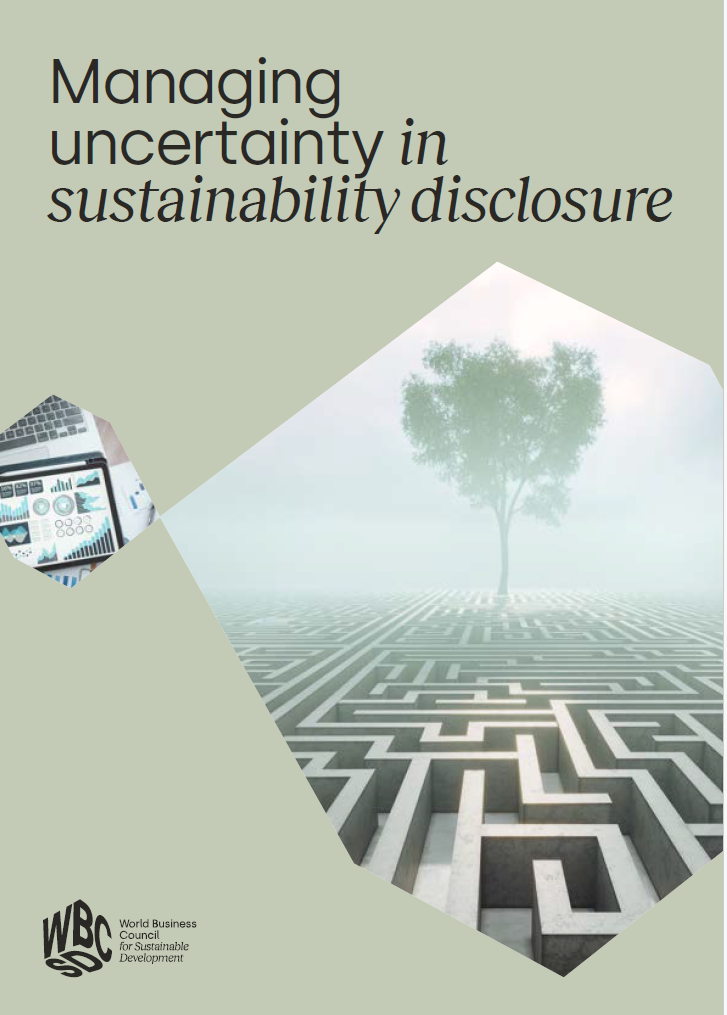Introduction
Terrafiniti, with our associate Lois Guthrie, is very pleased to have had the chance to support WBCSD’s Corporate Performance & Accountability (CP&A) programme to research, develop and write a new report, ‘Managing uncertainty in sustainability disclosure’, which was published in July 2025.

The publication provides analysis, guidance and examples of leading practice to support companies in navigating complex and challenging areas in sustainability disclosure – how they can explore and communicate the uncertainties they face and how they can disclose sustainability related financial effects.
The report combines our experience and insight together with exploration and discussion with a number of WBCSD’s members, disclosure standard setters, accountancy bodies, and investment experts.
It analyses and distils disclosure requirements, challenges and themes to provide guidance for companies to address uncertainties in preparing and disclosing sustainability information according to the European Sustainability Reporting Standards (ESRS) and the IFRS Sustainability Disclosure Standards (IFRS S1 and S2).
The types of uncertainty that organisations face
Sustainability performance increasingly influences a company’s financial outcomes. Investors and stakeholders seek clear, credible links between sustainability and financial data to guide decisions. Yet, due to its evolving nature, sustainability reporting is riddled with uncertainty – especially when trying to quantify financial impact.
As a relatively new discipline, quantifying and communicating the impact of sustainability performance on a business and its current and prospective financial results can be challenging and hampered by uncertainties.
These categories of uncertainty can include:
Decision uncertainty
This refers to the challenges that companies face in determining whether and how to assess and disclose sustainability issues. It includes uncertainty about whether a particular issue exists or is relevant to the business, how to judge its significance, and how to reconcile differing and potentially varied expectations from stakeholders, investors, and sectorally focussed approaches (i.e. where peer practice or rating agencies’ questionnaires establish a norm of certain disclosures for certain industries). It also encompasses ambiguity in interpreting disclosure standards – such as whether to report quantitative figures or qualitative insights – and how to handle advanced sustainability practices that go beyond compliance requirements, especially in relation to directors’ legal duties.
Output uncertainty
Output uncertainty arises when companies have gathered sustainability data but are unsure how best to present it. This includes difficulties in measurement due to limited data, unclear, emerging or contested methodologies, concerns about whether the information will be credible or useful to stakeholders, and confusion over how to tailor disclosures for different audiences. These factors can lead to reluctance to provide more comprehensive information, particularly if there is fear of misinterpretation or of accusations of greenwashing.
Process uncertainty
This arises when there are uncertainties concerning practical and operational aspects of sustainability reporting. It relates to whether companies have the necessary systems, resources, and internal structures to consistently collect, manage, and allow assurance of sustainability data and information. This includes decisions about which teams to involve, what budgets to allocate, and how to ensure reliable data management and verification practices.
Managing uncertainty in sustainability disclosure
Given the varied and multi-dimensional nature of the uncertainties which companies face there are a number of ways that these uncertainties could potentially be navigated and categorised. In order to aid practical action, the report provides a simplified structure to group and bundle uncertainty topics into a manageable number of overarching themes to support companies in navigating the complexity of uncertainty and provide guidance for their disclosure approaches.
Therefore, the report is structured around tackling four strategic themes:
- Integrating and connecting requirements: covering the alignment of sustainability and financial reporting cycles, processes, and outputs. It also addresses adapting risk management, governance, investment decision-making, and finance to support sustainability disclosure.
- Evaluating what (and how much) to disclose: focussing on the materiality assessment process, the use of judgment for materiality and significance, and the challenges of navigating different materiality perspectives.
- Making assumptions: discussing the use of assumptions in sustainability disclosure, the characteristics of credible assumptions, and the disclosure of assumptions.
- Measurements and estimates: exploring the information that should be disclosed about metrics, the characteristics required to provide the required context, minimise uncertainty, and maximise utility. It also includes information on different approaches to estimation when data is unavailable or unreliable, especially across the value chain.
Conclusion
The breadth, depth, and complexity of the uncertainties companies encounter in sustainability management and disclosure – particularly within a rapidly evolving economic, environmental, and social landscape – cannot be comprehensively addressed by a single publication. However, the report aims to support companies in identifying and taking steps that they can control to reduce or manage their uncertainties in sustainability management and disclosure to contribute to enhancing transparency and integrated, strategic decision-making. As sustainability continues to shape financial performance and stakeholder expectations, the ability to disclose with transparency, rigour, and relevance becomes not just a regulatory obligation but a strategic imperative. This report offers a practical steps and guidance for managing uncertainty and fostering more coherent, credible, and decision-useful sustainability disclosures. In doing so, it supports companies to move beyond compliance—toward leadership in sustainability accountability and disclosure.

 Sustainability disclosure in the UK – the new UK Sustainability Reporting Standards
Sustainability disclosure in the UK – the new UK Sustainability Reporting Standards
Leave a Reply